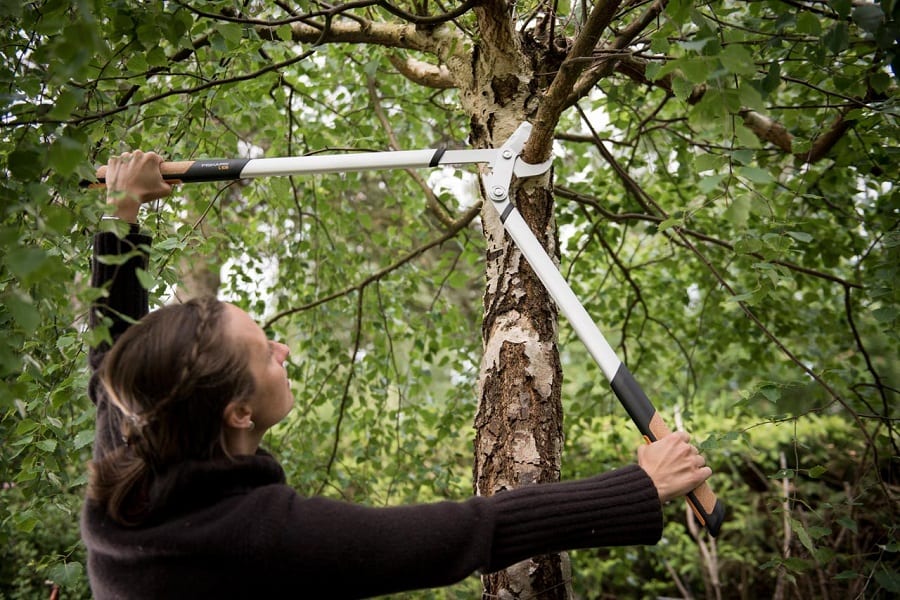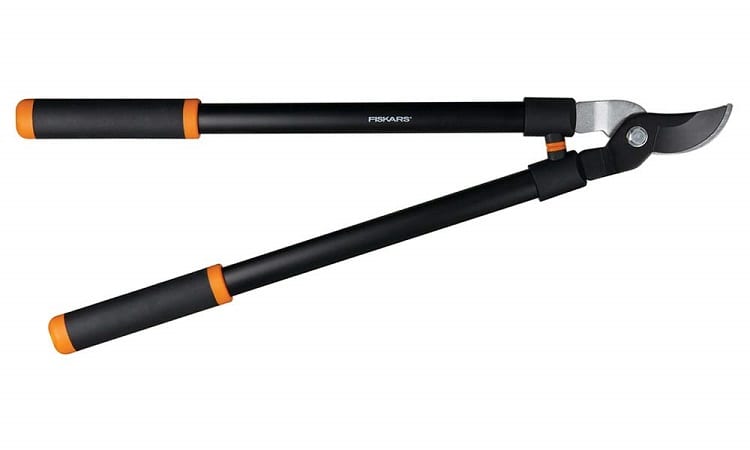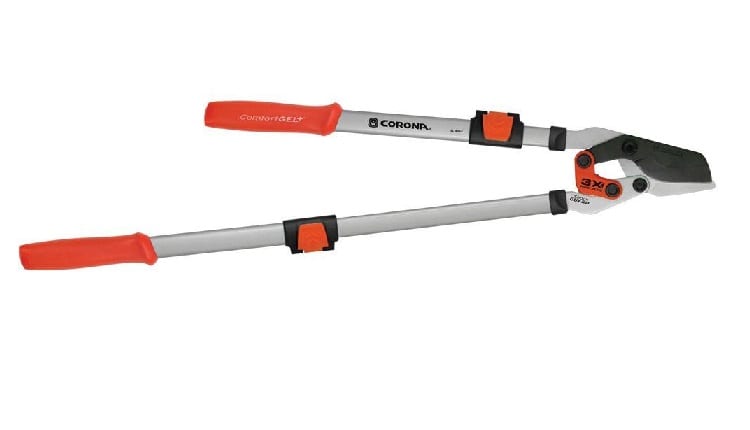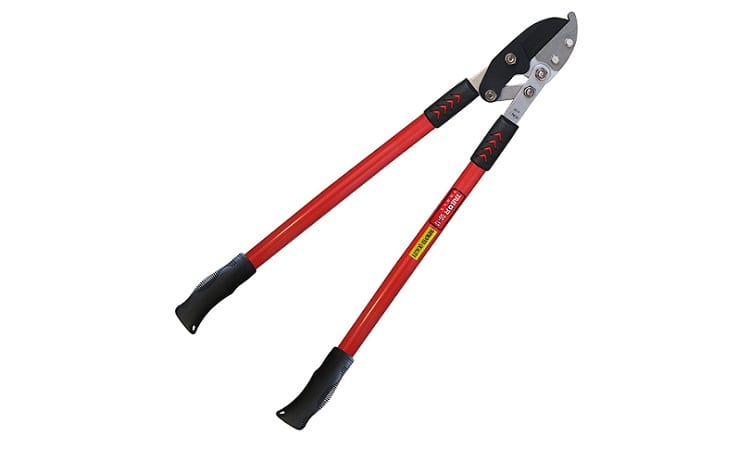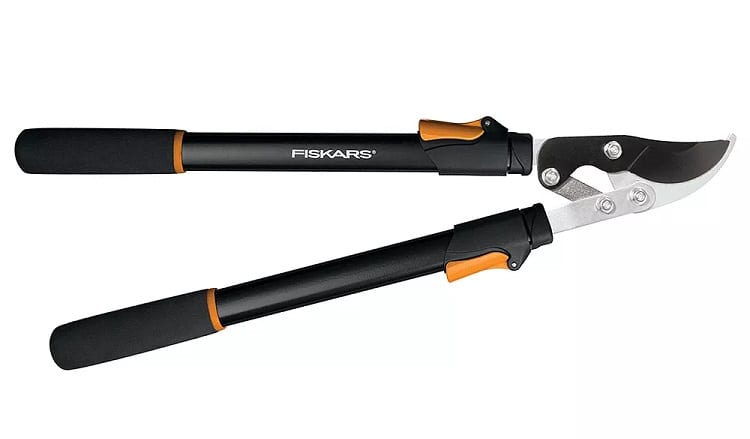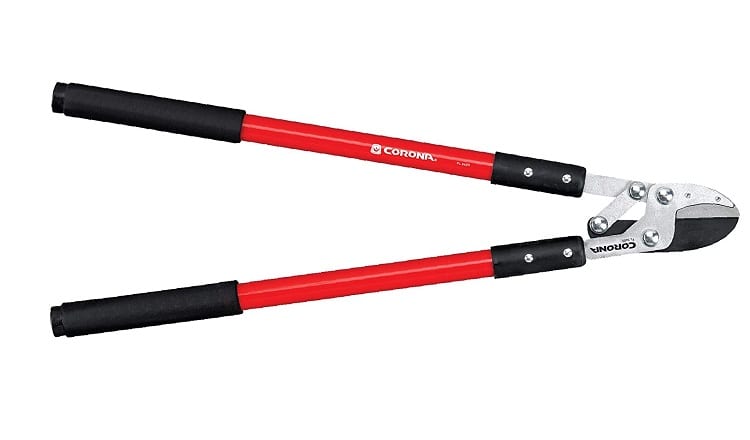Loppers are an essential garden tool that allows you to cut down strong branches.
They have extra long handles to take all of the difficulty out of the job. If you’ve been looking for new loppers for your garden, you’ve come to the right place.
The best loppers for your garden are the Fiskars 28 Inch Bypass Lopper Black/Orange. This lopping tool has strong, precision blades with a rust-resistant coating. They also have handles with a comfortable, ergonomic grip. The only disadvantage of this lopper is that it is only 28 inches in length.
In this lopper review guide, we take a look at the best garden loppers on the market. We cover all the pros and cons so you can make an informed choice. We also discuss the different kinds of loppers and how you can use them in your garden.
Table of Contents
Best Loppers For Your Garden – Reviews For 2021
Best Overall: Fiskars 28 Inch Bypass Lopper Black/Orange
Specs:
- Type: Bypass lopper
- Size: 28 inches (71.1cm)
- Weight: 2.9 pounds (1.3kg)
Benefits
The Fiskars bypass lopper is the overall best lopper for your garden. It has a simple but effective design that includes a precision blade. The blades are strong enough to cut through 1.5 inches (3.8cm) of the branch without damaging the lopper.
Its blades have a coating that is resistant to rust and reduces friction. This ensures the lopper will give you years of reliable use. It can also cut cleanly, which is essential for a bypass lopper. The garden tool is best suited to precision cuts that maintain the health and beauty of your plants.
The handles have long, comfortable grips. This allows you to get a good grip and make precise cuts. It also reduces strain on your wrist and fingers. The Fiskars lopper is a great choice if you have mobility issues or simply need to use it a lot.
Drawbacks
The main disadvantage of the Fiskars model is the length of the blades. It is the smallest garden lopper on this list. This could be a problem if you have very high branches in your garden. You should never overextend loppers because it reduces the power of your cuts.
Extra Features
The Fiskars bypass lopper has shock-absorbing bumpers between the handles. This prevents strong cuts from vibrating through your hands. This is a huge advantage, especially if you are a professional gardener. It prevents damage to your hands and reduces any potential pain.
Buying Advice
The Fiskars lopper is the best pruning lopper for your garden. It’s small but reliable, with sharp blades and reinforced handles. It is designed to reduce any strain on your hands and deliver precise cuts to smaller branches.
Runner Up: Corona SL 4364 Bypass Limb and Branch Lopper
Specs:
- Type: Extendablebypass lopper
- Size: 27.5-37.5 inches (70-95.3cm)
- Weight: 4 pounds (1.8kg)
Benefits
The Corona lopper has extendable handles that can reach up to 37.5 inches (95.3cm) in total length. This is perfect if you have tall branches in your backyard. You can extend the handles to the ideal length and use two hands to cut the wood.
These handles are made of trapezoid steel that is comfortable on the hands and reinforced for extra strength. They also have a ComfortGEL Grip that reduces any strain on the wrists or fingers. This makes the Corona lopper a good option for the elderly or those with big gardens.
The two-zone blade is sharp and strong enough to cut through wood up to 1.75 inches (4.4cm) in width. The lopper can cut limbs and branches, making it a diverse and multifunctional lopping tool.
Drawbacks
The main disadvantage of the Corona SL 4364 lopper is its weight. It is the heaviest lopper in our selection of the best loppers for your garden. While this extra weight allows the lopper to cut with more power, it can also take a toll on your back and shoulders.
We recommend taking regular breaks when using this Corona lopper. This will help to reduce any pain or damage from the weight of the unit.
Extra Features
It features a DualLink power-compounding link, which increases the power of cuts by up to 30%. This reduces pressure on your arms and also allows the lopper to cut straight through strong branches. You just need to be careful to hold the lopper with two hands and stand in a stable position so that the power does not destabilize you.
The lopper also has a shock guard bumper between the handles. It absorbs the impact of cuts. This means fewer vibrations through your arms and less wear and tear on the loppers. Overall, the Corona lopper is more heavy-duty than similarly priced loppers.
Buying Advice
If you’re looking for a long and heavy-duty bypass lopper, you can’t go wrong with the Corona SL 4354. It has sharp and powerful blades that can cut through thick branches with ease. It also reaches high places with a simple extension.
Alternative: TABOR TOOLS GG12A Anvil Lopper
Specs:
- Type: Compound-action anvil lopper
- Size: 30 inches (76.2cm)
- Weight: 3.68 pounds (1.7kg)
Benefits
The TABOR TOOLS GG12A is our pick for the best anvil lopper for your garden. It has more power and cutting ability than many other loppers at its price point. It’s also very affordable at less than $60.
It has a hardened carbon steel blade that is sharp and strong enough to cut through 2 inches (5cm) of a branch. The blade also has a coating which reduces sticking and minimizes friction. This allows you to make clean cuts and position the blades perfectly. This is essential especially if you are trying to preserve the health of your plants.
The handles have an ergonomic design that reduces wear and tear on your muscles. They have rubber grips that are comfortable and easy to hold, with no danger of slipping.
The lopper can reach up to 30 inches (76.2cm) in total, which is more than enough for medium-sized trees and shrubs.
Drawbacks
The main drawback of the TABOR TOOLS lopper is the bolt design on the cutting head. The bolts are not long enough that you can secure nuts on the ends.
Some users have reported that the bolts can fall out without you noticing. This can damage the blades if you continue to use them without the bolts.
Extra Features
The sharp blade has the assistance of the compound-action lever system, which has multiple pivot points and parts. This design allows the blades to apply 3x more force on the branches. This means that you need to simply close the handles together and the blades can apply their superior cutting power to the branch.
Buying Advice
If you’re looking for a powerful and user-friendly anvil lopper, you should consider the TABOR TOOLS GG12A. The blades are sharp and have a compound-action level system that delivers more power. The lopping tool is also comfortable and easy to use.
Alternative: Fiskars 25 Inch Extendable Power-Lever Lopper
Specs:
- Type: Extendable power-lever lopper
- Size: 25-37 inches (63.5-94cm)
- Weight: 3.65 pounds (1.6kg)
Benefits
The Fiskars Power-Lever Lopper has extendable handles that can reach up to 37 inches (94cm) in length. This is a huge selling point if you have tall trees in your garden. It removes the need to overextend your arms, which can cause damage to your neck and back.
The handles have Softgrip holds, which are more comfortable on your hands. Overall, the Fiskars lopper is user-friendly and suitable for the elderly and those with mobility issues. It makes the job easier and performs it with ease.
Its blades are made from precision-ground steel and have a light coating that is resistant to rust and minimizes friction. This combination allows the blades to make clean, powerful cuts. This is especially important if you are trimming branches for appearance purposes.
Drawbacks
One disadvantage with the Fiskars Power-Lever Lopper is that it can be difficult to use when fully extended. You need to open the handles wide to get around thicker branches, so this can be tricky at the full extension length.
Extra Features
The lopper is incredibly powerful. It has a compound-lever system, which has multiple parts. These parts work together to help the blades exert 2x the amount of force on branches. They can cut through wood up to 1 ⅝ inch (4cm) in diameter.
Buying Advice
If you’re searching for compound-action loppers on a budget, you should consider the Fiskars Power-Lever Lopper. It has a sophisticated lever system that allows the lopper to exert more force and extendable handles that can reach high places. It’s also very comfortable and has an ergonomic design.
Alternative: Corona Compound Action Anvil Lopper
Specs:
- Type: Compound-action anvil lopper
- Size: 32 inches (81.3cm)
- Weight: 2.67 pounds (1.2kg)
Benefits
The Corona Compound Action Anvil Lopper has a sharp blade and a high-carbon steel anvil blade. The cutting blade is strong and sharp, and the anvil blade has a PTFE non-stick coating.
This allows the blades to work together to crush and cut larger branches. Both blades are also replaceable.
The lopping tool has long handles of 32 inches (81.3cm). The handles are made from sturdy fiberglass and have comfortable non-slip foam grips. This allows the lopper to make powerful cuts and gives you full control over the positioning of the blades.
This lopper is designed for professional uses. It has a durable design that is resistant to damage and can give you years of reliable cutting.
Drawbacks
One drawback of the Corona lopper is that sometimes the handle grips move around. You might like to use gardening gloves with these lopping shears to strengthen your grip.
Extra Features
The Corona lopper has a compound-action lever system with four different levers. This design allows the lopper to exert 3x the amount of force on branches and hence cut through 1.5 inches (3.8cm). This intuitive design removes the need for you to use more force with your arms.
Buying Advice
If you’re looking for durable anvil loppers that have powerful cutting force, you should add the Corona Compound Action Anvil Lopper to your list. It has a simple but effective design that gets the job done. It’s also very affordable and great value for money.
Loppers FAQ
What Is the Difference Between Bypass Loppers and Anvil Loppers?
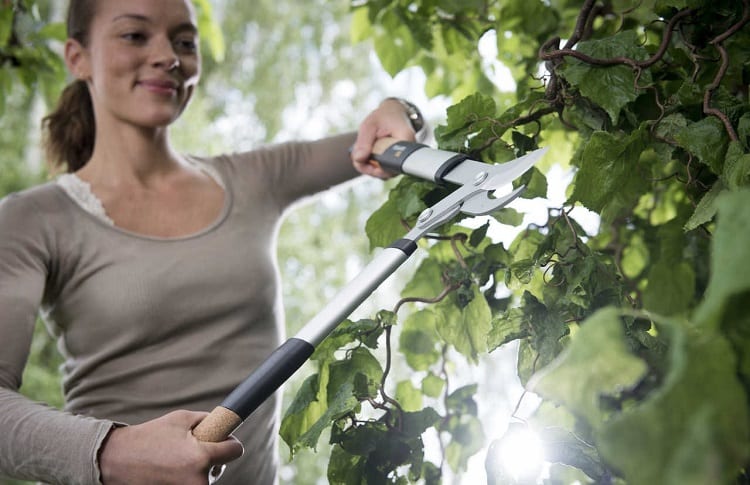
Bypass loppers and anvil loppers are the two most common types of lopping tools. They have different shapes and you use them for different jobs.
Bypass loppers are similar to scissors. One side has a sharp blade that moves past a lower jaw blade. The jaw blade holds the branch in place while the other blade cuts it. This movement past the blade gives the loppers the name of bypass.
They are sharp and precise. This makes them a good option for pruning and important cuts that impact the health of the plant.
There are different kinds of bypass loppers:
- Long-handled bypass loppers
- Compound-action bypass loppers
- Heavy-duty bypass loppers
Long-handled bypass loppers are the standard option. The long handles give you more leverage to cut stronger branches. They can also reach high branches or stems.
Compound-action bypass loppers have a compound hinge. This prevents the blade from twisting and increases the strength of the lopping shears.
Heavy-duty bypass loppers have reinforced blades and handles. They can cut heavier and stronger branches without damaging the lopping tool.
Anvil loppers have different blades. They have a single sharp blade on the upper jaw that cuts against a flat anvil. The anvil is softer than the metal of the cutting blade.
Anvil loppers crush at the same time as they cut. For this reason, they are not precision tools. You usually use anvil loppers to remove dead plant matter or when making preparation cuts. More precise cuts need bypass loppers.
There are a few different kinds of anvil loppers:
- Standard anvil loppers
- Ratcheting anvil loppers
- Compound-action telescoping loppers
- Gear-drive anvil loppers
Standard anvil loppers work by cutting and crushing at the same time. They are sometimes adjustable for different shapes of branches.
Ratcheting anvil loppers are more powerful because they use hydraulic or pneumatic pressure. Releasing the pressure exerts a lot more force on the branches than a standard anvil lopper.
Compound-action telescoping loppers have a compound-action hinge. This increases the strength of the cutting force. The extra-long handles of the telescoping loppers also increase the power of cuts.
Gear-drive anvil loppers have geared heads and handles. This allows you to change the position of the blades and also increases the strength of the cuts.
Anvil loppers and bypass loppers serve different functions. Therefore, you should use both in your garden.
What Is the Difference Between a Lopper and a Pruner?
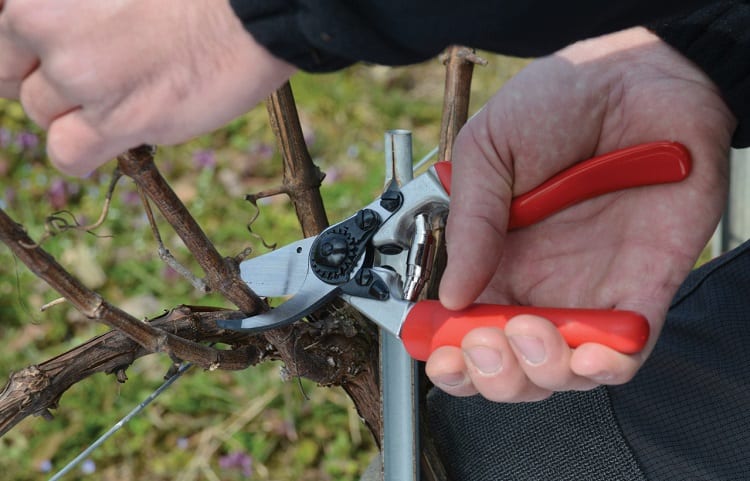
Pruners are also called pruning shears. They are much smaller than loppers. They are roughly the size of your hand and have shears that are a few inches long. Pruners can cut leaves, thin branches, flowers, and offshoots.
Pruners come in three different types:
- Anvil pruners
- Bypass pruners
- Parrot-beak pruners
All types are small enough that you can use them with one hand. They are lightweight and designed to minimize damage to the fingers and wrist. They can have blades made from either stainless steel or carbon steel.
You can use pruners on plant sections that are no thicker than 2cm (0.79 inches) in width. Gardeners use pruners in the following environments:
- Regular gardens
- Arboriculture
- Plant nurseries
- Farms
- Flower arrangements
- Nature conservation
If you need to cut thicker branches, then you need to use loppers. They are also called lopping shears. Loppers are like a longer, stronger version of pruners. They can cut thick branches without damaging the blades or hurting your hands. They have long handles that can reach high places from the ground.
Loppers can cut branches up to 2.5cm (1 inch) in width. You need to use two hands with loppers to get enough pressure to cut through the wood. The handles are usually between 12 inches (30cm) and 36 inches (91cm) long.
Loppers come in two different types:
- Bypass loppers
- Anvil loppers
Both kinds are significantly larger and heavier than pruners.
Loppers are best suited to the following purposes:
- Fruit trees
- Hedges
- Thin branches of common garden trees
You should have at least one pair of pruners and a pair of loppers in your garden shed. This will allow you to cut any kind of foliage in your garden.
How to Use a Lopper?
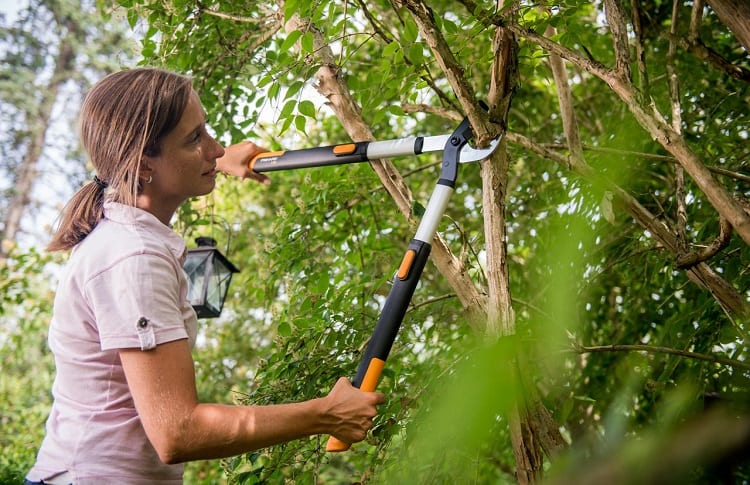
Before using loppers, you need to put on appropriate safety gear. You should use gloves to protect your hands and safety goggles to protect your eyes. The force of the loppers can send pieces of branch flying and it could injure you.
Once you have your safety gear on, you can start using loppers.
- Line up the position of your lopper blades. You want to get the blades in the correct position for where you want to cut.
- Get the wood into position. Open the loppers and position the wood inside. Make sure that it is as far into the blades as you can get.
- Make the cut. Use two hands to firmly close the handles together and cut the wood.
You should also follow these tips to keep your loppers in good condition:
- Don’t overextend. Reaching loppers high above your head can reduce the effectiveness of the loppers. It could also injure you.
- Keep them straight. Do not twist your loppers while cutting. This can make the cut messier and even damage your lopping shears.
- Use them for their intended purpose. Don’t try to use loppers on large and thick branches. This can break them. A hand saw is a more appropriate tool for large branches.
- Keep them clean and sharp. Wipe your loppers clean after every use and sharpen them frequently. You may also like to use oil to prevent rust.
How Do You Sharpen a Lopper?
You need to sharpen loppers regularly. This makes sure that the tool is making clean cuts. This means your loppers will last longer and also allows plants to heal faster from the cuts.
Before you sharpen the lopper, you need to clean it. Take care to remove any plant matter, dirt, dust, or other grime.
You can use a flat-file or a hone to sharpen a lopper. We recommend using the Corona Garden Tool Blade Sharpener for better results.
- Hold the loppers open with the blade facing up. It is easier to sharpen loppers in natural lighting. When the light reflects most strongly off the blade, this shows that the cutting bevel is level.
- Use the file or sharpener on the blade. Move from the back to the tip in a single motion. Repeat this several times until the blade is sharp.
- Rotate anvil loppers. With the cutting edge facing you, repeat step 1.
- Repeat step 2.
When you are sharpening anvil lopper blades, you need to remember to remove the same amount of metal on both sides. If you sharpen the cutting blade and remove a lot of the edge without doing the same on the anvil side, there will be a gap.
Once you have sharpened the blades, apply a lubricant. This protects the blades from getting dirty and increases their functionality.
Conclusion
In conclusion, this article contains the best loppers for your garden.
Whether you are looking for anvil or bypass loppers, you should consider loppers that have reinforced blades, rust resistance, and enough power to cut through branches.
Particularly if you have mobility issues, you should look for garden lopping shears that have extendable and comfortable handles.
Loppers are an important tool to cut branches that are too thick for pruners and too thin for a pruning saw. Make sure to choose a reliable model that will give you years of use and precise cuts.

